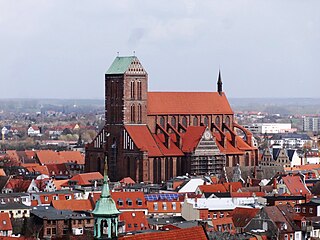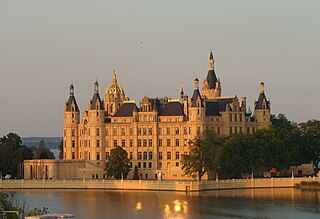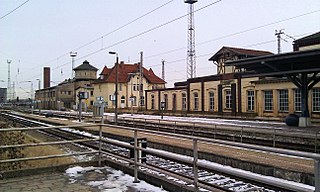
Mecklenburg is a historical region in northern Germany comprising the western and larger part of the federal-state Mecklenburg-Western Pomerania. The largest cities of the region are Rostock, Schwerin, Neubrandenburg, Wismar and Güstrow.

Mecklenburg-Vorpommern, also known by its anglicized name Mecklenburg–Western Pomerania, is a state in the north-east of Germany. Of the country's sixteen states, Mecklenburg-Vorpommern ranks 14th in population; it covers an area of 23,300 km2 (9,000 sq mi), making it the sixth largest German state in area; and it is 16th in population density. Schwerin is the state capital and Rostock is the largest city. Other major cities include Neubrandenburg, Stralsund, Greifswald, Wismar, and Güstrow. It was named after the two regions of Mecklenburg and Fore Pomerania.

Wismar, officially the Hanseatic City of Wismar is, with around 43,000 inhabitants, the sixth-largest city of the northeastern German state of Mecklenburg-Vorpommern, and the fourth-largest city of Mecklenburg after Rostock, Schwerin and Neubrandenburg. The city was the third-largest port city in former East Germany after Rostock and Stralsund.

Schwerin is the capital and second-largest city of the northeastern German state of Mecklenburg-Vorpommern as well as of the region of Mecklenburg, after Rostock. It has around 96,000 inhabitants, and is thus the least populous of all German state capitals.
Nordwestmecklenburg is a Kreis (district) in the north-western part of Mecklenburg-Vorpommern, Germany. It is situated on the coast of the Baltic Sea and borders on Schleswig-Holstein to the west. Neighboring districts are Rostock, Ludwigslust-Parchim and the district-free city Schwerin, and the district Lauenburg and the district-free city Lübeck in Schleswig-Holstein. The district seat is the town Wismar.

Bad Doberan is a former district in Mecklenburg-Vorpommern, Germany. It was named after its largest town, Bad Doberan, the German Bad meaning spa. The district surrounded the City of Rostock, bordering the Baltic Sea in the north as well as the former original districts of Nordvorpommern, Güstrow and Nordwestmecklenburg. The district was disbanded at the district reform of September 2011. Its territory has been part of the district of Rostock since.

Poel or Poel Island, is an island in the Baltic Sea. It forms the natural northern and eastern boundaries of the Bay of Wismar on the German coast. The northern coast of the island is also on the south side of the large gulf known as the Bay of Mecklenburg, which Wismar Bay enters into. Insel Poel thus forms on its northern side the unofficial latitude of the northern boundary of the Wismar Bay.

Dassow is a town in the Nordwestmecklenburg district, in Mecklenburg-Western Pomerania, Germany. It is situated on a bay of the Baltic Sea, 20 km east of Lübeck and 2 km south of Lübeck-Travemünde. It is also close to the cities of Wismar and Schwerin, and is part of the Hamburg Metropolitan Region.

Schwaan is a municipality in the Rostock district, in Mecklenburg-Vorpommern, Germany. It is also the seat of the Schwaan Township, serving another six municipalities.

Dorf Mecklenburg is a municipality in the Nordwestmecklenburg district, in Mecklenburg-Vorpommern, Germany. It is located 6 km south of Wismar. It is home to the castle "Mikilenburg", that gave its name to the whole region known as Mecklenburg.

Glasin is a municipality in the Nordwestmecklenburg district, Mecklenburg-Western Pomerania, Germany.

Lübstorf is a municipality in the Nordwestmecklenburg district, in Mecklenburg-Vorpommern, Germany.

Mecklenburg Castle was a medieval castle and a residential capital of the Nakonid and Nikloting dynasties of the Obotrites. It was located just south of the modern village Dorf Mecklenburg, seven kilometres south of the Bay of Wismar in Mecklenburg-Vorpommern, Germany. The only remnants of the ruined castle are parts of an earthen wall. Some scholars have associated Mecklenburg with the medieval trading emporium Reric.

The Hagenow–Schwerin railway is a double track electrified mainline railway in the German state of Mecklenburg-Vorpommern. It is the second oldest railway in Mecklenburg after the Berlin-Hamburg railway and one of the oldest railways in Germany, opened in 1847 by the Mecklenburg Railway Company.

Bad Kleinen station is in the community of Bad Kleinen and is one of the oldest and most important railway stations in the Mecklenburg-Vorpommern, Germany. It primarily operates as a transfer station for traffic to and from Wismar, Grevesmühlen / Lübeck, Schwerin and Bützow / Güstrow / Rostock.

Ludwigslust-Parchim II – Nordwestmecklenburg II – Landkreis Rostock I is an electoral constituency represented in the Bundestag. It elects one member via first-past-the-post voting. Under the current constituency numbering system, it is designated as constituency 13. It is located in western Mecklenburg-Vorpommern, comprising the eastern parts of the districts of Ludwigslust-Parchim and Nordwestmecklenburg, and the northwestern part of Landkreis Rostock.

Blankenberg (Meckl) station is a railway junction in the German state of Mecklenburg-Vorpommern. The station was opened on 13 May 1850 and is one of the oldest railway stations in this state. It is at the intersection of the Bad Kleinen–Rostock and the Wismar–Karow railways. Regular passenger services run only on the former route. Most of the Wismar–Karow railway is closed, but between Blankenberg, Sternberg and Dabel there are occasional freight trains.
During its history, the state of Mecklenburg has been repeatedly partitioned into various successor states. Modern historians distinguish three main Partitions of Mecklenburg:





















